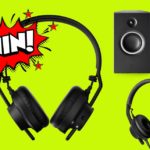6 Comments
We sometimes joke that DJing is five years behind the rest of the world when it comes to technology, and so it is with USB-C cables. Long the standard for consumer electronics, USB-C is slowly creeping into the DJ world too, on controllers and mixers.
In this article, I’ll tell you what you need to know if you encounter DJ gear that has USB-C as the socket to plug your computer in, or that has USB-C as a power option (or both).
Watch the show
Prefer me to talk you through this? In this video, a recording of a live show from the Digital DJ Tips YouTube channel, I talk you through everything in this article, and we take questions from our community on the subject.
USB-C Cables For DJing: What You Need To Know
USB-C cables of course have the flat, symmetrical plugs that are now pretty common on laptops and desktop computers instead of the old USB-A plugs and sockets. They’re used for everything from charging phones to connecting gear together.

Previously, Apple had its Lightning connectors, and Android and other devices had Micro USB, printers and DJ controllers had USB-B, but slowly everything’s switching to USB-C, and indeed it will be law in the EU for devices to use these connectors shortly, with strong rumours that even Apple is to tow the line 100%, abandoning Lightning in its remaining devices (phones and a few headphones) that still use it in favour of USB-C.
So in this article, I’ll share with you all you need to know to make the switchover painlessly as your gear switches to this new standard.
What if I get a piece of DJ gear with a USB-C socket on it?
If it has just one USB-C socket, and no other power input, that means that it doesn’t need external power, and can take power from the laptop you’re going to plug it into, just like how the old USBs worked. That’s good news – but your next job will be to check you have the right cable.
Whether your laptop has the old-style USB-A sockets, or newer USB-C sockets, it will definitely work with your controller, so first, don’t worry! Your controller manufacturer will have bundled a cable with your unit, but if it’s the “wrong” one (ie it has a USB-A on the “laptop” end when you need a USB-C, or vice versa), you’ll need to either buy an adaptor, or a new cable with the correct plug on each end. Both methods will work fine, although the second is probably more reliable in the long run.
Read this next: When To Upgrade Your Gear (And When To Wait)
(Likewise, by the way, if your laptop only has USB-C sockets and you want to plug in an older-style DJ controller that has a – still very common – USB-B socket, you’ll probably discover that the gear comes with a USB-B to USB-A cable. But again, you can either use an adaptor, or buy a new USB-B to USB-C cable. It’ll work fine.)

Basically, whatever the combination of new/old laptop and new/old DJ gear, you just need a cable with the right plug to fit your laptop’s USB socket, USB-C or USB-A, and your DJ gear’s, USB-C or USB-B. There’s absolutely no issue with just getting the right cable to work with both devices – it’ll always work fine, as it’s doing the same thing, it’s just a different “shape”. Note that the USB-C “shape” replaces all old cables, at “both” ends (DJ gear and computer). All old-style USB-A, USB-B and Micro USB plugs are now universally being replaced with USB-C.
How many goes does it take to plug a USB-A cable in?
The old joke about USB-A cables it that it takes three attempts to plug them in: The first wrong attempt, the next attempt when you turn your cable around and try again only for it still not to fit, and the third attempt when you turn it back to how you had it before, and miraculously it fits.
No such issues with USB-C cables – they are designed to fit in the socket whichever way up you plug them in – another advantage of the new way.
What if my DJ gear has two USB sockets around the back?
Unless it has USB-C sockets so two laptops can DJ with it at the same time, usually a second USB-C means that it also has a USB-C shaped power input, called USB PD.
Traditionally, if DJ gear didn’t have the big, pro IEC power input (where you plug in a standard “kettle lead”), it had a small, round socket to plug in a provided cable, complete with an external transformer to drop the voltage down from high to 9V, 15V, whatever.
This was and is fine, but the problem is that these leads all tend to be different from each other, and should yours break, you may struggle to replace it. Wouldn’t it be nice if power could be provided over USB too?

Enter USB PD, a “power delivery” option using USB-C cables. If you have a modern laptop, you may have already seen this – perhaps your laptop came with a pretty heavy duty transformer, but instead of the above type of plug on the “computer end” of it, it had a USB-C plug. that’s “USB PD”.
The confusion that sometimes happens with DJs here is that they think they can use any USB-C power source with DJ gear and it’ll work – and that’s not always the case. That small USB-C power adaptor that came with your mobile phone is unlikely to properly power your DJ mixer – it may have the same-shaped plug at the end of the lead, but it won’t give enough “juice”.
When a USB-C socket on a piece of DJ gear is used for power (again, this will be where there are two or more such sockets around the back – usually it’ll be the only one that DOESN’T have a pic of a little laptop next to it), it needs “USB PD” or “USB power delivery”, and you’ll need a proper USB PD adaptor for this socket.

When a USB PD adaptor connects to a device, it “asks” the device how much power it needs. USB PD supports seven voltage levels at 5V, 9V, 15V, 20V, 28V, 36V, and 48V. But you needn’t worry about this: As long as you’re using a good quality USB PD adaptor that can provide at least as much power as your DJ gear needs, you’ll be fine. The trick is to check the manual if you’re substituting the provided power lead for a replacement. Once you plug in a suitable power adaptor you’ll be good to go.
Bottom line
It’s fine to replace cables with old-style USB plugs on them, for ones with the new-style USB-C plugs, if and when you need to. Just get a cable where the “other end” is the right style to fit whatever you’re plugging it into, usually your laptop or controller of course.
Learn to DJ with us: The Complete DJ Course
And if you need to power something (mixer, controller, etc) via a USB-C socket, make sure you use a USB PD power adaptor that can deliver at least the voltage your device needs, which you can check in your device’s tech spec. Don’t worry about getting one that’s “too powerful” – it’ll deliver the right power automatically.







